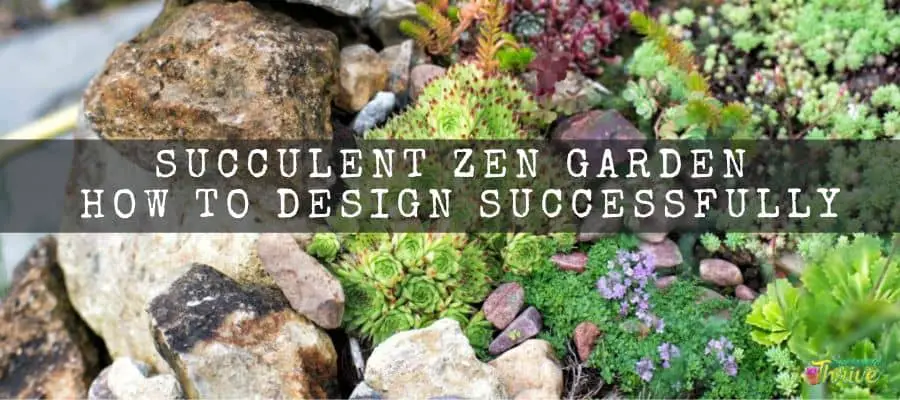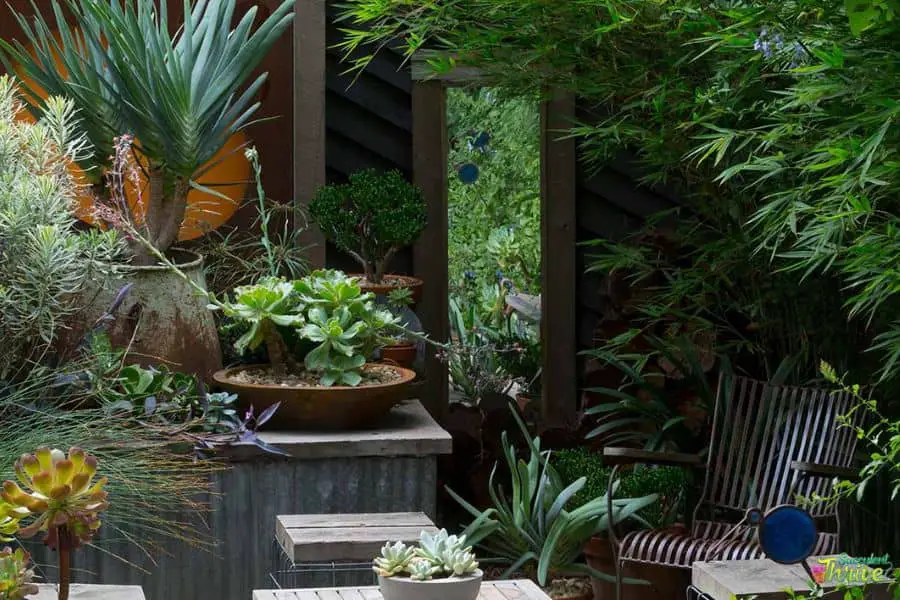Whether you’re a seasoned gardener or new to the world of plants, a succulent zen garden is a fun and rewarding project that anyone can tackle. Not only do these gardens look beautiful, but they also provide a sense of peace and relaxation, making them the perfect addition to any space. So grab your gardening tools and let’s get started on creating your very own succulent zen garden!
You only have to arrange a few supplies to make the succulent Zen garden a success. However, the results would be truly overwhelming. So, let’s get into it and learn in depth how to make a succulent Zen garden.

Why do you need succulent Zen gardens?
It is a true many people spend most of their time indoors or in front of a screen. It is very unlikely that people spend a lot of time in nature.
As per the research conducted, many people believe that once you spend a lot of time with nature or if you interact with the plants a lot, it will minimize your stress levels. However, the good side is that people who can’t stay outside can bring some nature into their living space. Incorporating a Zen garden into your home, on the other hand, will give the impression that you are connected with nature.
If we consider succulents in general, they help you to stay calm and relaxed. In fact, they would make you feel better than the rest of the other plants do. The reason behind that is because most of the succulents would be blue and green, which are tranquil colors that are soothing to look at. There are some succulents that produce enchanting flowers as well. They would keep you energized and make you feel overwhelmed. On the other hand, if you wish to have a mix of colors, you could go for succulent flower arrangements.
Types of succulents which you could use to make a Zen garden
Succulents in general have thick leaves and tissues, which act as water-conserving plant materials. There could be both succulents and cacti that serve this purpose. Their succulent ability to produce showy, glossy leaves and attractive flowers makes them an ideal addition to your Zen Garden. So, consider adding the plants listed below to your succulent Zen garden.
Aloe Perfoliate – mitre aloe
One might think aloe plants are ideal only to heal burns. However, these plants are also visually stunning. Mitre aloe is a good plant to use here because it grows in a creeping fashion. They go by the common name of “rubber aloe. They would usually come up with smaller rosettes. Further they would contain spike tipped leaves as well.
Echeveria elegans– Mexican snowball
Echeveria elegans is commonly known as the Mexican rose. They would usually form light mint rosettes too. They would stand alone on a piece of driftwood. Furthermore, you may also use these plants as the centerpiece in larger gardens as well.
Euphorbia cereiformis – Milk barrel cactus
Euphorbia cereiformis is a cactus type, and they are known as Milk Barrel Cactus in general. They would grow in a column shape. Furthermore, they would contain spiked ribs too. Milk barrel cacti form offsets, and they would vary in their heights. It is very easy to take care of them, and you would feel truly fulfilled to spot them flourishing.
Haworthia fasciata – Zebra plant
Haworthia fasciata has inherited the common name “Zebra Plant” due to the white stripes on its dark green leaves. In addition to that, their triangular-shaped leaves, which form into rosette shapes, are another highlight of these plants. In terms of the heights of the plants, they would reach about four to six inches when they reach their full potential. Consider growing them if you have a tiny space, as this would be a perfect addition for a tiny space.
Opuntia microdasys albata – Bunny ears
When you call it Bunny Ears, one might think it is a soft cactus. In real life, however, you can see them carrying tiny spines on their foliage. They would not contain a stem or a trunk as they grew. Instead, they would grow with segments that stacked on top of each other. If there is enough room, they can grow up to five feet in height. That said, if you grow them in a tiny container, they will stay small.
Sedum dasyphyllum – Corsican stonecrop
The distinguishing factor of the Sedum dasyphyllum plants is that they would have multiple stems. Further, they would be covered with tiny, light blue-colored leaves as well. If you have grown them in a pot, you could witness them growing in a cascading manner.
All these succulents are such great additions that you could add them to your Zen garden, and it is very easy to create the Zen garden with the succulents.

About Zen Garden arrangements
Zen succulent gardens depict an aerial view of the sea, shore, etc. To make them, you could use small pebbles and sand. Stone depicts the islands and mountains. Sand would represent water. Further, the other designs you use to make the Zen Garden represent either waves or ripples. If you don’t like the design you came up with, you could smooth it by using a small houseplant rake.
How to make a Zen Garden
First of all, you need to arrange the following supplies to proceed with this project:
- Shallow, decorative bowl
- Small succulent
- Sand (2 colors)
- Small paper cup
- Small rocks (for decoration)
- Chopstick or other ‘drawing’ tool
Usually, spotting one or two succulents, decorative rocks, and some other materials is a common sight in Zen succulent gardens. However, many people tend to use sand for doodling purposes. You could either use sand or rocks for the doodling. You can usually find various colored sand and various types of stones to use for this task. Next, you need to look for a shallow bowl where you could put all the materials and the succulents you have for this project; furthermore, you need to choose a soil mix that has excellent drainage and place it in a portion of the bowl.
Next, cover the plant’s roots with soil. Then, depending on your preference, surround the plants with sand or pebbles before filling the bowl. The plant’s roots will be grown in soil while ensuring sufficient top space to create Zen designs. You could spot new growths within a few months’ time. However, you could trim it back if you wish to change the concept of the garden.
It is best to locate this in a spot where the plants can gain morning sunlight, as that would be beneficial for the plant’s healthy growth. If you wish, you may try low-light plants such as Haworthia, Gsteria Gollum Jade, or even string buttons, as they can perform well in bright sunlight or in morning sunlight. Succulents need a little water in general. However, I suggest you check the plant’s soil moisture condition and apply a little bit of water if necessary. Do not make the sand wet, as it would be harmful for the setting of the Zen garden.
Zen garden maintenance
Many Zen gardeners tend to rake the gravel and sand with long, curving strokes. In fact, you can repeat the pattern as many times as you want. However, make sure there is at least 5 cm of sand left to work with. Sand may tend to look a little dirty after a few days.
Related questions
Are Zen gardens Japanese or Chinese
Zen gardens are one of the most recognizable aspects of Japanese culture.
What are the plants you could put in Zen garden apart from succulents?
- Hakonechloa. Hakonechloa macra. …
- Quince. Cydonia oblonga. …
- Rhododendrons. Azalea ‘Rosebud’
- Araiostegia parvipinnata. Araiostegia parvipinnata.
- Cherries. Prunus ‘Pink Shell’
- Japanese maples. Acer palmatum ‘Sango-kaku’
- Wisteria.
- Peonies.
Conclusion
Once you’ve completed all these tips, you can just wait and watch them flourish. Succulents are interesting and low-maintenance plants. They would come up in various shapes, sizes, colors, and with different features as well. So, if you ensure that you provide sufficient sunlight and look after them well, they will reward you with an amazing succulent Zen garden.
Read Next : Best Pot For Snake Plants
